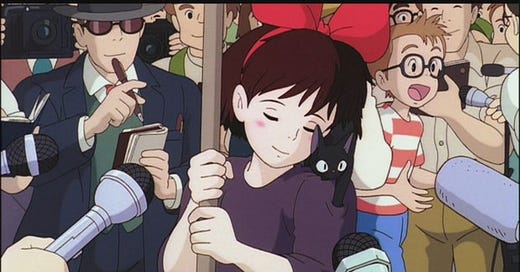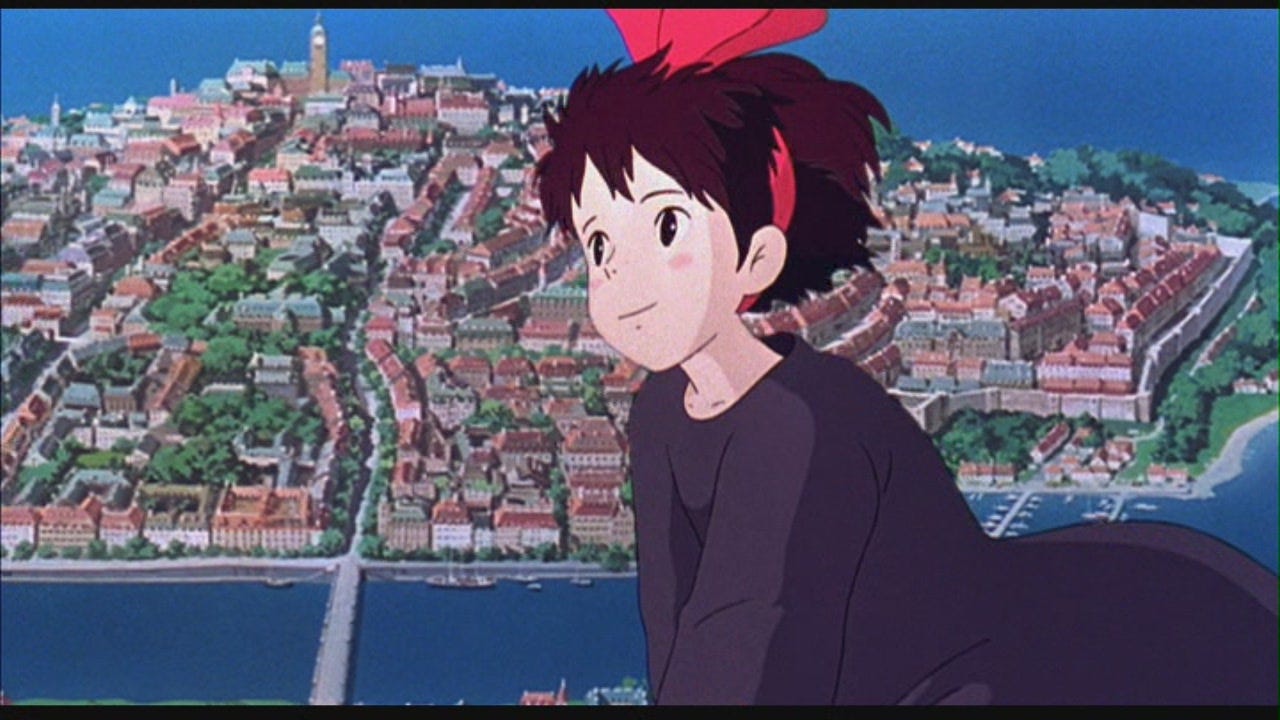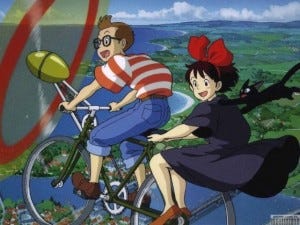Originally published at Entropy Magazine in 2015.
2015 is the 30th anniversary of the founding of Studio Ghibli and, according to Hayao Miyazaki, it may also be one of its final years as a studio. Because this is one of my favorite films studios and Miyazaki is one of my favorite artists, who’s made some of my favorite films, I’ve decided to go through the history of Studio Ghibli one film at a time.
If you’re looking for the discussions of the previous weeks:
This does, however, mean I won’t be discussing Nausicaa of the Valley of the Wind, which was made before the founding of the studio.
I’ll also only be discussing the Japanese audio version of the films, though that doesn’t mean the dubs are bad or not worth seeing. They’re just slightly different. I’ll also be discussing these with the assumption that they’ve been seen by you. So, yes, spoilers are below.
Before we get into things, I will say something about the dubbed versions quickly, mostly with regard to the dubbed version of Kiki’s Delivery Service.
These first three Miyazaki films were dubbed differently than the later ones. More sounds were added into the film, which removed a lot of the quiet moments. Also, there’s simply more dialogue. The films become much chattier in English. All of these changes were approved by Miyazaki and, for the most part, the films aren’t significantly different. Castle in the Sky has a lot more jokes, with Pazu cracking wise pretty often, and the air pirates are more obviously comedic. Also, the voice actors in the dub are much older than the Japanese voices, which makes Pazu and Sheeta feel like teenagers rather than adolescents. Other than that, the film has the same tone and feel.
The English and Japanese versions of Kiki’s Delivery Service, however, are quite different. Or, they are to me. There’s all the extra noise and chatter, sure, but there are also big changes. For one thing, Jiji is voiced by a man instead of a female. That man is the late great Phil Hartman, and is, I believe, his last performance. His dialogue is a bit different and he’s cracking wise pretty regularly when Jiji is silent in the Japanese version. More than that, Jiji becomes a more sarcastic character. There’s also a very small change to the English script which amounts to a huge difference between the English and Japanese versions, but I’ll get to that later.
So, yes, the dubs of Miyazaki’s films are incredibly well done in comparison to most English dubs of east Asian film, but they are different. I do think the dubs are worth watching, especially if you’re watching with children or don’t mind the differences. I mean, I watched most of Miyazaki’s films in English when I saw them for the first time, so it’s hard for me to tell you not to do the same.
Anyrate, onto the film.
Kiki’s Delivery Service is, in my opinion, one of the weakest Miyazaki films. Of course, the worst of Miyazaki still holds up pretty well when compared to most animated films, but that’s just how I feel. It’s not a favorite of mine and likely never will be. That’s not that the film is bad, but that it doesn’t resonate with me the way most of his films do. The only film of his I like less is Porco Rosso, which I’ll be discussing in a few weeks. I’m actually very excited to watch that one because I’m secretly hoping it’s not how I remember it.
But I’ll put that aside for now. I actually enjoyed this more than I previously did. It’s a very solid film but it’s also a very ordinary film, in many ways, especially when compared to My Neighbor Totoro or many of his films that come later, like Princess Mononoke, Spirited Away, and Howl’s Moving Castle, which are certainly when he’s at the top of his game.
But I keep wandering around and not discussing the film at hand!
This is a very straight forward and simple story. Where My Nieghbor Totoro is about early childhood, Kiki’s Delivery Service is about stepping out of childhood and gaining independence, both literally and figuratively.
We begin in a small town where witches are celebrated members of the community. Kiki is the daughter of the village witch and, as a thirteen year old witch, it’s time for her to set off on her own and settle down in a new place to become the witch of that place.
It’s a tradition.
And this film has a curious implicit discussion of tradition, which seems important in Japan, where the cultural divide isn’t just between east and west, rich and poor, but between generations. Youths, adults, and the elderly live in vastly different worlds with enormous gaps in expectations, and this can be seen in Kiki. For example, she takes her witching less seriously than her mother did, which makes her a pretty mediocre witch. But when she comes to her new city, she’s shocked and appalled at the familiarity shown among her peers and the dismissive attitude they have towards their older relatives.
Kiki lives in a strange limbo between tradition and modernity. She’s a witch, which by itself is a throwback, but she has all the desire to fit in with the children her age and be a part of the modern city she finds herself in. At the same time, she seems to feel most comfortable with older generations.
It’s an interesting balance. She being a walking tradition that wants to be a part of the modern world while she also holds onto many traditional values.
What I find most interesting about the film is that Kiki isn’t exceptional. I mean, yeah, she’s a witch and knows magic, but being a witch isn’t really different from being a baker or doctor or janitor in this world. It’s just a different skillset. Sure, most people don’t have that skillset and can’t gain it, but the same could be said of painting, writing, filmmaking, ballet, and on and on.
I touched on this a bit when discussing Laputa: Castle in the Sky. Miyazaki very much tells stories about ordinary people. I didn’t discuss this aspect in My Neighbor Totoro, but if you watch that film you’ll find that everyone involved is a normal person. People plant rice paddies and work in the village. The father is a professor at a university. The mother is sick and in hospital. The girls are just normal children.
Kiki is a very normal teenage girl. The only thing exceptional about her is that she’s a witch. The fact that most people don’t see this as exceptional is interesting. Perhaps more interesting since teenagers in the city she moves to seem to be indifferent to her being a witch or treat her with outright disdain for being a witch. It’s also interesting that Kiki isn’t an exceptional witch. In fact, she’s not really very good at being a witch. The only useful witching skill she has is her ability to fly.
We learn early on that Kiki has no real witching skill to speak of. She meets another witch as she leaves her hometown who talks about her own ability to divine the future and how that’s her marketable skill.
Kiki sort of thinks to herself and realises she has no such skill that will make it easy for her to make a living.
But she finds kindness in a baker in her new city named Osono who hires her as a delivery person after she proves how useful she can be. She gives Kiki a room to stay in and even free breakfasts, so long as Kiki helps out in the bakery. She also allows Kiki to set up her business there.
And so she uses her ability to fly to make a living. Even here, though, she runs into all kinds of trouble. Her first job requires that she very simply take a cat doll from point A to point B, but very little goes right. What should have been a quick delivery turns into a daylong adventure, where Jiji must pretend to be a cat doll, Kiki needs to fight with birds, and then reclaim the original cat doll, which ends up in the hands of an artist living in the forest outside of the city.
Kiki’s business never really takes off either. She gets a few jobs here and there. Enough to make money for her to live on, but she never really thrives in the city. I mean, that’s not unusual, considering she only just started her business, she’s still a child, and no one really knows her.
But to go along with her normal person status, a lot of attention is paid to her ability to make money, the need for her to get receipts from her customers, and this random kind of minutiae that would normally be absent from a film about a child with an intended audience full of children. In most films we see now, everyone is well off and has little worry about money. This is especially true when we think of animated films in the west, where no one really has a job and everyone has unlimited income. Thinking especially right now of Big Hero 6, which is an amazing film, but makes almost no sense if you consider economics.
But none of that is what Kiki’s Delivery Service is really about. It’s about growing up, how that can feel impossibly hard, and how we need to learn to love ourselves before we can gain acceptance. A young boy named Tombo is immediately fascinated by Kiki when she flies into the city, but Kiki tries her hardest to ignore him throughout much of the film. She’s put off by his familiarity and probably because she’s unaccustomed to having the interest of boys, especially when she’s beginning to notice boys.
A lot of this deals with vulnerability and the transition into adulthood. Kiki eventually warms up to Tombo, after they go on a pretty exciting and dangerous bikeride through the city. But even before that, it’s clear that she desperately wants to be liked by him, even as she shoves him away.
One of the moments that most clearly shows Kiki’s vulnerability and innocence is a scene that would be cut out of 99 out of 100 children films. The morning after her first night with Osono, she creeps down to the outhouse to use the toilet. As she’s about to return to her room, she sees Osono’s husband approaching. Rather than be seen by him, she closes the door again and then watches as he walks away, stretching his muscles. Once he’s out of sight, she runs back to her room and closes the door, panting.
It’s a perfect moment that does absolutely nothing for the plot, but it shows us the isolation and innocence and vulnerability of this thirteen year old girl newly transplanted to an unfamiliar city where she’s expected to begin a life and take care of herself.
Before she befriends Tombo, her true companion is Jiji, her black cat. During most of the film Kiki and Jiji can communicate as if they’re speaking the same language. It’s clear that adults and non-witches can’t understand Jiji. Despite the thematic elements Jiji represents, which I’ll get to, he’s also just a great character. He’s funny and mischievous and very cautious. He serves as a sort of guardian and adviser for Kiki.
All of these elements come together. Kiki loses her confidence in herself as life in her new city becomes more and more difficult. As she finds acceptance hard to come by and successes few and far between, she becomes depressed.
Before she leaves on her bikeride with Tombo, she speaks to Jiji and leaves him behind. After her bikeride, she and Tombo share some beautiful moments on the beach. Their friendship blossoms and Kiki is stepping out of her childhood innocence. But upon returning home, she finds that she can’t communicate with Jiji anymore. Further, she discovers that she can’t fly.
Literally powerless, she becomes depressed.
All confidence dashed, all hope lost. The thing that defined her for her whole life is not missing. Her greatest friend and confidant is incomprehensible. She’s now just a girl in a new city.
It’s then that the painter she met in the forest comes to see her.
They discuss art and magic, which are more or less the same thing. This is a very old idea, perhaps captured best by Shakespeare, but touched on by most artists throughout history. Creating art is magic, in that you’re literally creating something new that other people can experience.
Kiki finds companionship in the painter, something she’s sorely been missing, especially without Jiji.
Eventually Kiki regains her confidence in a series of dramatic moments that come to a life and Death climax. She saves Tombo’s life from a runaway dirigible while all the city watches, and probably many beyond the city. It’s captured on television and the radio and an enormous crowd is there in person. Kiki must learn to become what she always knew she was without trying.
She must grow up.
She needs to become who she is. It’s no longer so simple to just be who and what she is.
She relearns her art, her magic, and in doing so she saves the day and finds acceptance on an immense scale.
And that’s where we end.
Kiki saving the boy in distress and becoming famous.
Or, there’s one more thing.
Though Kiki’s magic returns, she still can’t understand Jiji. Jiji hops onto her shoulder and meows. Rather than be defeated, she nuzzles into him. This is a very significant moment that is utterly lost in the English version.
See, in the English version, an added line of dialogue implies that Kiki can once again understand Jiji, because they believed this would be too sad for western audiences.
I think this undermines a lot of the film, because this is a really sad moment, but it’s also very powerful.
Jiji is strongly attached to Kiki’s childhood. He’s a fundamental part of it, and in losing Jiji’s voice, Kiki must stand up and be herself. She must grow up and find independance.
Which she does.
Kiki’s Delivery Service will never be a favorite of mine, but that doesn’t lessen its quality. It’s an absolutely wonderful film and a great coming of age tale. It’ll likely be a long time till I watch it again, but I strongly recommend this, especially if you have kids to watch it with. I imagine they’ll fall in love with Kiki and Jiji.






